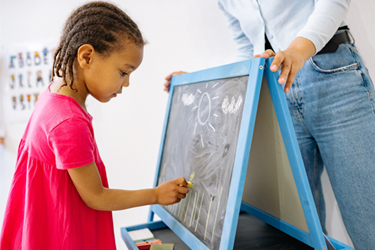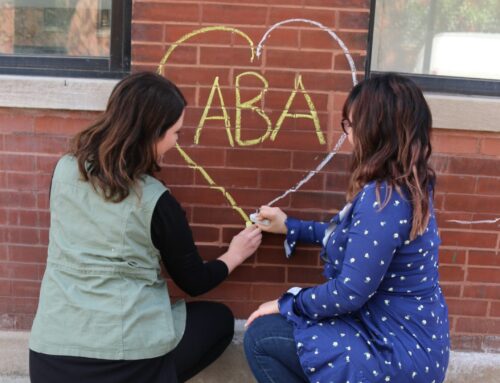Toddlers and preschoolers are notorious for getting into EVERYTHING. Emptying bookshelves, dumping toy chests, and getting their little hands on anything they can reach. It is amazing how fast a little one can burn through all the toys on the toy shelf! This is largely because, like all other developmental skills, preschooler’s attention spans are still growing and developing. In order to engage with our little ones effectively, it is important to meet them where they are (i.e., where their attention span is). Expecting a preschooler to independently attend to a single activity for more than 20 minutes is sure to bring about a variety of difficulties. But supporting a 3-year-old during a 5-minute activity can bring about the quality type of engagement that supports language and cognitive development.
So, what can we realistically expect from our two, three, and four-year-olds in terms of attention? Studies suggest that the average preschooler’s attention span is between three and six minutes. This means most preschoolers can attend to a single activity, like playing with cars or stacking blocks, for 3-6 minutes independently. Older preschoolers, 4 and 5-year-olds, have a slightly higher attention span, approximately 6-10 minutes. These figures are slightly increased, but still generally below 15 minutes when given direct adult support. This is an important thing to keep in mind when planning activities and setting expectations for our little ones.
Here are some simple ways to support your child’s attention span and appropriately encourage its growth:
Provide frequent breaks
If your activity involves sitting or being still, be sure to incorporate frequent motor breaks to allow your child to get some of their excess energy out and to provide physical regulation. These can be quick dance parties, a tickle break, or an interactive yoga session! Remember, many tasks can involve movement! Playing a game of tag, hide–and–go–seek, or simple imitation games demands the same attentional skills as tabletop or floor activities. Speech tip: Narrate your actions! Use this time to practice one and two-step directions and imitation.
Read the signs your child is giving you
If you see your child fidgeting in her seat, turning her body away from the activity, or staring off into space, listen to her nonverbal language and provide her with a break! Speech tip: Give your child language for what they are feeling: “You look like you need a break”, “I can see that you need to move around!”

-
Choose activities that have a definitive endpoint
Puzzles and simple games are a great way to engage your child in an activity that has a clear beginning and endpoint. Your child may be more likely to stick with an activity or respond to redirection, knowing they are approaching a final endpoint where the task will be complete. Speech tip: Help them see this endpoint by using language such as “Two more turns until we are all done,” or “First find the puzzle piece with Micky’s head, and then our puzzle is all done!”
Keep activities age-appropriate
Introducing a game or puzzle that is too complicated for your child will likely cause them to lose their attention more quickly. Much of this may be trial and error, and that is okay! Try to find that sweet spot where the activity is simple and engaging but can provide opportunities to practice new skills or learn a new language. Speech tip: Keep your verbal directions short and simple. Model the activity for your child prior to asking them to do it on their own. Narrate the steps you take in your activity.

-
Incorporate your child’s unique interests
Just like adults, preschoolers are more likely to engage with a new activity if they are genuinely interested in it. Utilize your child’s interest when planning new play topics and activities. Incorporate your child’s favorite characters, like PJ Masks or Daniel Tiger, into your next play session. Speech tip: This is a great opportunity to model language concepts such as pronouns and modifiers/descriptions.
Be mindful of the demands that are being placed on your child
Children’s attention spans fatigue more quickly whenever we challenge them with a cognitive, communication, physical or behavioral demand. This is especially important if your child has sensory differences. Remember: Sitting still is considered a significant demand for a preschooler.
Sleep and health
Poor sleep and health dramatically affect the attention span of both adults and our little ones. Ensure healthy sleeping and lifestyle habits to promote healthy attention and learning!
As we learn to respect our preschooler’s attention span and use appropriate measures to meet them where they are, more of our time together is spent in meaningful interaction that develops language and cognition skills rather than in behavior management. Remember to have fun and enjoy your preschooler’s growing mind!
References:
Gaertner, B. M., Spinrad, T. L., & Eisenberg, N. (2008). Focused Attention in Toddlers: Measurement, Stability, and Relations to Negative Emotion and Parenting. Infant and child development, 17(4), 339–363. https://doi.org/10.1002/ICD.580
Ruff, H. A., & Capozzoli, M. C. (2003). Development of attention and distractibility in the first 4 years of life. Developmental Psychology, 39(5), 877–890. https://doi.org/10.1037/0012-1649.39.5.877

Blue Bird Day fosters socialization, sensory regulation, and pre-academic learning in children ages 2-7 years in therapeutic rotations that simulate preschool and kindergarten settings. Our compassionate therapists practice a relationship-based and family-centered approach, provide parent training, and collaborate on goals and individualized intensive treatment plans for your child.
We believe in a collaborative and multi-disciplinary team approach to therapy. A team of occupational therapists, speech-language pathologists, dietitians, developmental therapists, behavioral therapists, physical therapists, and therapeutic assistants are created for each child to ensure child and family are fully supported and the best possible results are achieved.
Options for individualized, group and virtual therapy sessions are available as well.
Want to learn more or you have a specific question? Feel free to connect with us here!



